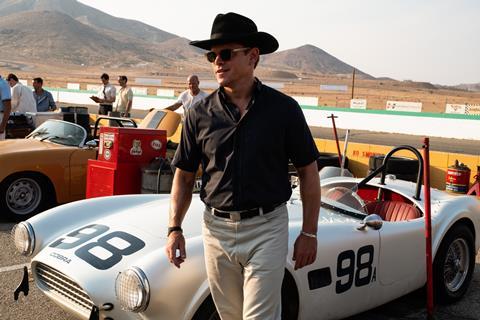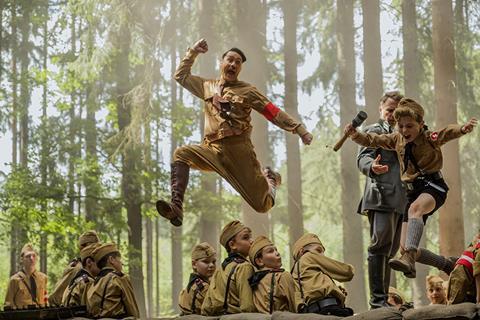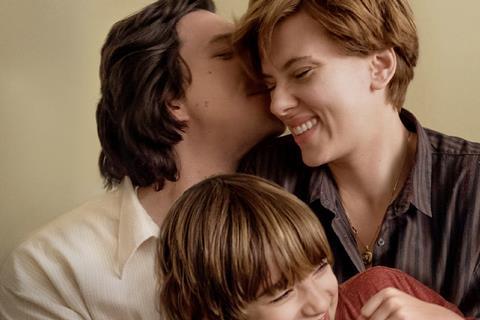The Irishman and Joker look set to battle it out for the Editing category at the 2020 Academy Awards, writes Adrian Pennington.

Le Mans ‘66
The real-life story of Ford’s attempt to build a race car that could beat the Prancing Horse stars Matt Damon as American car designer Carroll Shelby and Christian Bale as British-born driver Ken Miles.
“It was never intended to be Days of Thunder,” says editor Michael McCusker. “We wanted the same visceral experience as that film but it’s a little less flash than what [director] Tony Scott was doing.”
Nor was director James Mangold interested in telling the story of man versus machine which is the focus of Hunt v Lauda drama Rush: “Like all of his movies, Jim is concerned about character.”
In this case, the main editorial challenge was laying out the groundwork at just the right length and depth for the relationship between Carroll and Ken to take over.
“The task was to introduce everyone, get the expository work done in an efficient way and then move to the more straightforward narrative. We moved a couple scenes around until we found the right order. You could just feel there was a momentum to it. When it clicks like that you know you have the movie.”
McCusker joined the project a couple of months before principal photography to develop the race scenes in pre-viz.
The film’s opening sequence and the first race among other scenes were edited by Andrew Buckland, who graduated from assistant editing on several Mangold projects like Wolverine to full editor credentials (with McCusker) on The Girl on the Train.
“I’m not the fastest guy in the world so we’ll divide scenes up, particularly if I’m trying to finish another scene, and Drew will run with it,” McCusker says. “We are very good friends.”
- Read more: Behind the scenes: Le Mans ‘66
Parasite
Director Bong Joon-ho’s home invasion thriller explores class divide in Korea, with the struggling Kim family occupying the luxurious Park family mansion with violent results. Winner of the Cannes Film Festival’s Palme d’Or, Parasite is tipped by many critics as the best film of the year too.
Editor Jinmo Yang worked with the Joon-Ho on previous films including Okja and is familiar with the director’s storyboarded style of shooting for a cut that’s almost pre-designed.
“What usually happens is we create the assembly on set, editing in rough sequence, and then move on to the actual editing, where we find the right music and recut the sequences there,” Yang explained to Indiewire. “We tweak the timing of every shot, perfecting the rhythm, even if it means stitching together various takes together as one shot.”
The most difficult shot to edit was the look on Mr Kim’s face during the climactic birthday party when his emotions tip over into violence.
“Bong and I went through so many takes and versions. We dissected it and looked at the expressions Ki-taek was making,” Yang told Variety. “We had to sell that emotion and where he was coming from. The entire film hinges on that very moment.”
The Irishman
Martin Scorsese may switch cinematographers, actors and genres but the one creative constant on all his features since Raging Bull has been Thelma Schoonmaker. The three-time Academy Award-winner returns with the director to New York’s mean streets in a time-hopping narrative complicated by copious de-aging visual effects.
In an interview for American Cinema Editors, she calls Scorsese’s concept for this film “daring” because of its slower pace and without the flashy camera work and editing with which the Scorsese/Schoonmaker partnership has become renowned.
“I was worried about it at first. We moved a few minor scenes and dropped a few, but the beautifully thought out structure of the film worked so well that the film came together more quickly than we expected.”
They toyed with building in an interval for the film’s theatrical run but in test, screenings found audiences so engaged that they left its three-and-a-half-hour time in intact.
“The long slow build of the film was so original, and paid off so movingly at the end, that we felt an intermission would ruin the movie,” Schoonmaker says. “In fact, we only dropped about 10 minutes during the editing process.”
The pivotal scene is when Russell Bufalino (Joe Pesci) instructs Frank Sheeran (Robert DeNiro) to assassinate his best friend, Jimmy Hoffa (played by Al Pacino).
“The language is deliberately opaque. DeNiro barely moves as he begins to understand he is being sent on a terrible mission, but you feel exactly what he is feeling. These scenes were shot very early and so I knew right from the beginning that Irishman was going to be an exceptional movie.”
- Read more: Behind the scenes: The Irishman

Jojo Rabbit
It’s fair to say that Taika Waititi’s anti-hate satire has divided critics with some citing the triteness with which they believe the writer-director has approached such a touchpaper subject, with others commending its connection with audiences. It won the people’s choice award at the recent Toronto film festival, following in the footsteps of Green Book, and has landed several Oscar nods too.
Walking the line between the gravity of the holocaust and the absurdity of the situation as its presents to the mind of a 10-year old child was the chief editorial challenge of editor Tom Eagles.
“It was a constant balancing act, all the way through the edit,” he told Deadline. “We were constantly recalibrating, taking jokes out, adding jokes back in. How much humour was too much? How much darkness was too dark?”
The editor has worked with Waititi before, notably on Hunt for the Wilderpeople, and this is his first Academy Award nomination. They found black and white footage of Nazi propaganda cheering for Hitler and a German version of Beatles hit, I Want to Hold Your Hand. These are paired at the beginning of the film to illustrate mass hysteria.
“It’s easy to forget that a lot of people loved Hitler and saw him as a father figure,” Eagles commented to Awards Daily. “We originally had the real Hitler in there. In the end, it was better to play shots of the back of his head or cut away just as he appeared in the shot. We focused instead on the hands and communicated this mass hysteria of people just wanting to touch him.”
Joker
Few films caused as much controversy in 2019 as the origins story of Batman’s nemesis whether because its sequestering of Martin Scorsese’s acerbic King of Comedy felt unearned or its use of a Gary Glitter track betrayed its snowflake-provoking pretentions. Either way, Joker hit a nerve.
“Because he is the main character you have to be sympathetic with him and his situation to even watch the movie,” editor Jeff Groth told IBC365. “The character is kind of romantic. He doesn’t want things to be the way they are but the world dumps on him and it gets worse as he discovers more about his life.
“He is ultimately always destined to be Joker but when he puts on the Joker mask he is, in fact, taking off the mask of Arthur.”
Groth picks out a pivotal scene in Arthur Fleck’s transformation when he first puts on white make-up but is yet to fully add the Joker’s face. “It encompasses so much emotion and tension, horror, and humour. His face is so beautiful and at the same time kind of tragic.”
In an unusual move, Groth cut the movie as consecutively as possible, working on set for much of principal photography. “I found this helpful because you can see the progression of the character and story, from beginning to end,” he says.
- Read more: Behind the scenes: Joker
Near misses

Marriage Story
In writer-director Noah Baumbach’s drama, a coast to coast switch becomes the straw that tips the couple, played by Scarlett Johansson and Adam Driver, over the edge into divorce.
“I found it fascinating that the script functions almost like a thriller,” editor Jennifer Lame told CinemaEditor. “The procedure of divorce itself drives the plot. You want to find out what happens next.”
There are several dialogue scenes of almost screwball comedy, notably one in which Driver’s character is served divorce papers.
“I wanted to make sure that the energy and humour were high leading up to Adam’s entrance, but that it wasn’t so distracting that the audience wouldn’t be ready for the emotion of what comes next. It’s the feeling of being so blindsided, and of having an out of body experience when your world as you once understood it is turned completely upside down in a moment, which we worked hard to get across.”
Next up for Lame: Christopher Nolan’s latest, Tenet.
Once Upon A Time in Hollywood
In 1969, struggling actor Rick Dalton (Leonardo DiCaprio) and his buddy Cliff (Brad Pitt) happen to be neighbours to the beautiful, fast-rising star Sharon Tate (Margot Robbie).
“The story is basically a slice of life for these characters,” explains editor Fred Raskin. “You see them go about their days but there’s a sword of Damocles hanging over them because you know that at some point the Manson family is going to show up.”
Director Quentin Tarantino’s script rejects conventional movie structure. The first couple of hours are virtually plotless, making it tricky for the editor to find a rhythm and tone that would repay the viewer’s patience in the third cathartic act.
“Finding the movie and getting it down to reasonable length was honestly the greatest challenge,” Raskin says. “He always writes and shoots more than he necessarily intends there will be in the theatrical version. We go into the edit knowing that certain things, certain characters even, are not going to end up in the final cut. That’s kind of an elementary part of editing any film.”
Oscars 2020: A closer look at the VFX award nominees
- 1
- 2
- 3
 Currently reading
Currently readingOscars 2020: A closer look at the Editing nominees
- 4



























No comments yet